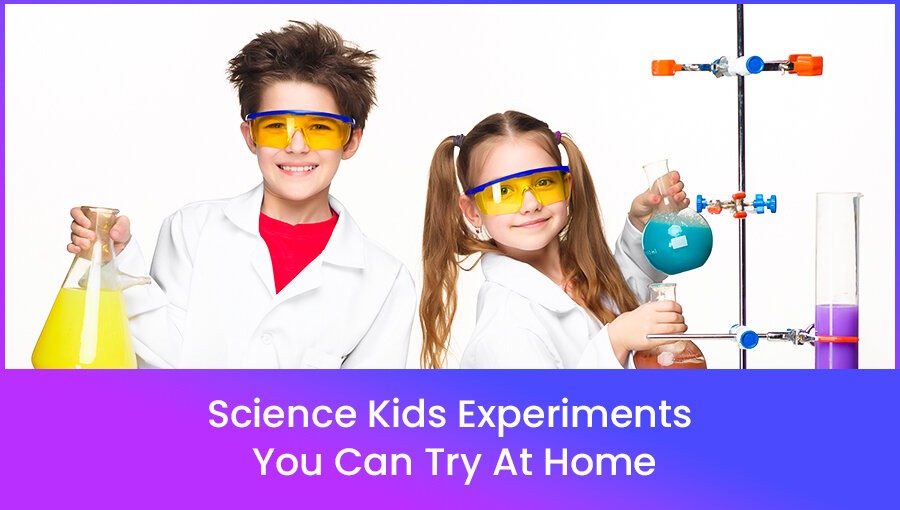Science is all about what is happening around us. We keep hearing and reading about Science, science experiments and STEM all the time. We know it is important as it lets us better understand the functioning of the world, and we hope that our kids, too, develop an interest in the field!
But the question arises, “how do we develop this interest?”
How about “Science Kids Experiments?”
Engaging our kids in some science experiments at an early age and helping them understand what Science is and why it is important can surely spark an interest. Hands-on experiments are an excellent way to involve kids in a hands-on learning experience that has a long-lasting impact. Such activities can boost their interest and involvement in STEM, not just Science.
So, let’s dive into our recommendations of “science kids experiments that you can try at home”, covering concepts around gravity, capillary action, solvent, solution, solutes, germination and density.
Blossoming Beans
This experiment aims to introduce and educate kids about the concept of germination. Apart from theoretical teaching, the experiment also covers the “what and how” involved. This hands-on experiment is easy to conduct and will help kids learn by doing.
Materials needed: paper towel, spray bottle and water, pinto bean, zip lock bag or plastic/glass jar.
Instructions:
- Dampen the paper towel and place it in the container of your choice.
- Place bean/s on top of the wet towel. If you’re using a jar, put the towel on the sides of the jar.
- Close the container and place it in a warm sunny spot.
- Keep adding water to the paper towel using a spray as it dries.
- Keep a check on the growth through regular inspection and watch your plant grow in 3-5 days.
‘Through this experiment, kids will see germination first-hand and observe the plant(s) grow as it’s a soil-free environment. The process will also help kids cultivate soft skills like consistency, patience and discipline. The best part is that kids can observe the plant grow as it’s a soil-free experiment.
Floating Egg
Does an egg float in water? What would happen if you put an egg in a glass of regular water? These questions can be intriguing not just for kids but for adults too. Here’s this easy experiment that you can quickly try at home. This experiment aims to teach kids about the concept of density.
Materials needed: 1 egg, water, salt, tall and wide glass, and a spoon.
Instruction:
- Take a glass half full of water.
- Place the egg in the glass and ask the child to observe if it’d sink or float (it’d sink).
- Take 1 tbsp salt and stir it until it dissolves.
- Keep adding salt to the water until the egg floats.
- Pour more water until the glass is nearly full and ensure you don’t disturb the saltwater layer.
- Be very careful as you pour more water into the glass. If you’d do it with utmost precision, chances are you can get the egg to float between freshwater and salt water.
This experiment aims to teach kids about density. As the egg is denser than fresh water, the egg sinks. Adding salt to the freshwater increases the density. The egg starts to float as the water becomes denser than the egg. Upon pouring more fresh water, you create a layer of less dense water on top of the denser saltwater solution, and the egg can float between the two layers of water.
Water Walking
This experiment is going to be the best one on this list. Kids will love watching the colour moves from one cup to another. The process allows you to teach them about two different science concepts: gravity and capillary action.
Material needed: 5 cups, water, yellow and blue colouring agents, yellow and blue (you can use food colour or watercolour), and paper towels.
Instruction:
- Keep all cups filled with water in a circle leaving a little room to soak in the paper towels.
- Add different colours to alternate cups, i.e., 1st, 3rd and 5th cups.
- Make bridges between the cups by soaking one half of a paper towel in one cup with colour and the other half in the next cup with clear water. The coloured water will move to the cup next to it through the paper towel.
This transfer of colour through a paper towel is called capillary action. The water travels through the tube-like fibres of the paper towel. These fibres pull the water upwards from one end against gravity due to the attractive forces between the water and the towel. This process happens in plants as water travels upwards from the roots.
Skittles Patterns
Kids love their candies. How about using candies to introduce them to the concepts of solvents, solutes and solutions? Let’s get started.
Material needed: Skittles Candy, deep dish, and water.
Instruction:
- Arrange Skittles in a circle or heart shape in a bowl.
- Make sure you take a big bowl with space between the candy arrangements.
- Add a little water and watch the candies melt.
Skittles are pure sugar, so they dissolve as soon as you add water. ‘Stay focused, keep watching, or you’ll miss the fun part. As the candies dissolve, you’ll see coloured swirls coming from each candy. Kids love to see these colours getting mixed.
These fun experiments are an excellent way to introduce kids to STEM concepts. Give a try and see a spark of excitement in your kid’s eyes.
Stay connected to more such informative posts.


